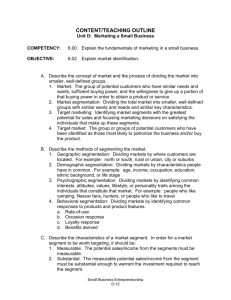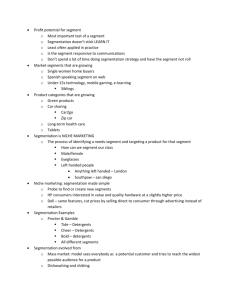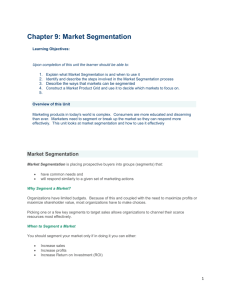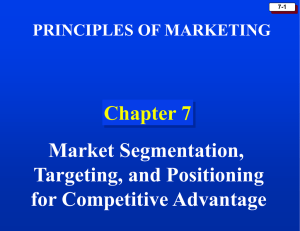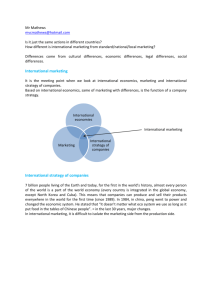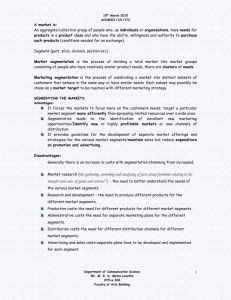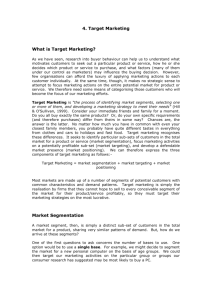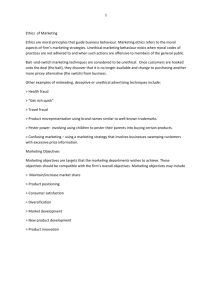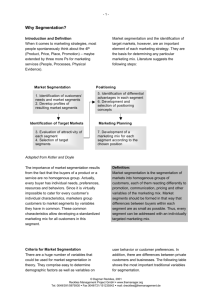Document
advertisement
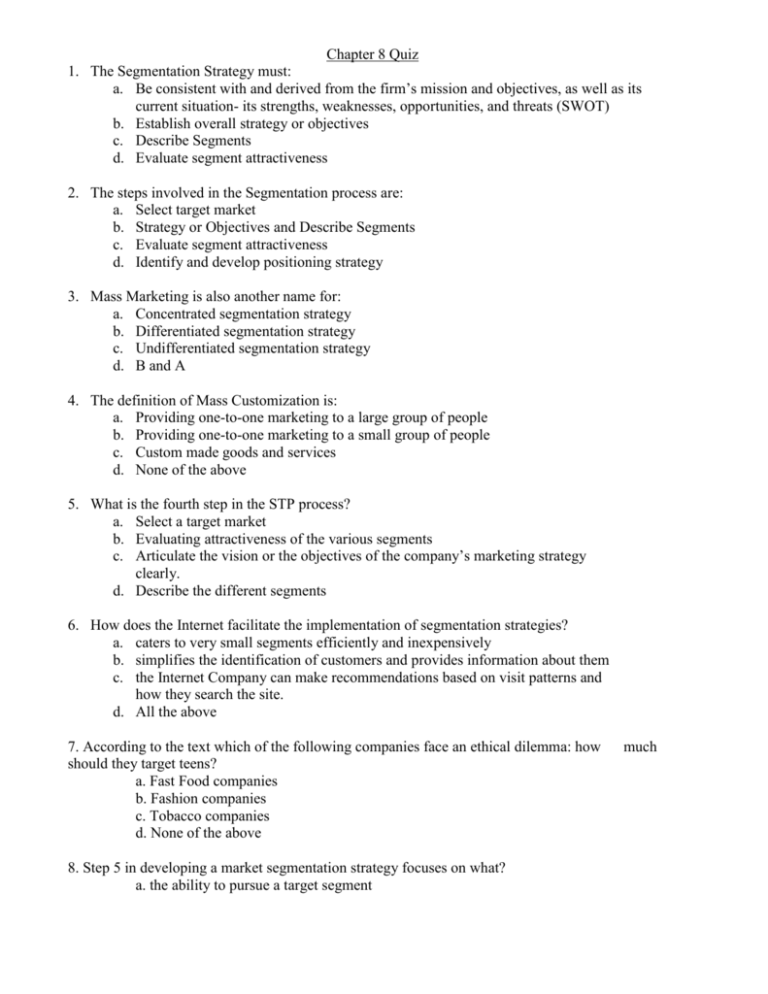
Chapter 8 Quiz 1. The Segmentation Strategy must: a. Be consistent with and derived from the firm’s mission and objectives, as well as its current situation- its strengths, weaknesses, opportunities, and threats (SWOT) b. Establish overall strategy or objectives c. Describe Segments d. Evaluate segment attractiveness 2. The steps involved in the Segmentation process are: a. Select target market b. Strategy or Objectives and Describe Segments c. Evaluate segment attractiveness d. Identify and develop positioning strategy 3. Mass Marketing is also another name for: a. Concentrated segmentation strategy b. Differentiated segmentation strategy c. Undifferentiated segmentation strategy d. B and A 4. The definition of Mass Customization is: a. Providing one-to-one marketing to a large group of people b. Providing one-to-one marketing to a small group of people c. Custom made goods and services d. None of the above 5. What is the fourth step in the STP process? a. Select a target market b. Evaluating attractiveness of the various segments c. Articulate the vision or the objectives of the company’s marketing strategy clearly. d. Describe the different segments 6. How does the Internet facilitate the implementation of segmentation strategies? a. caters to very small segments efficiently and inexpensively b. simplifies the identification of customers and provides information about them c. the Internet Company can make recommendations based on visit patterns and how they search the site. d. All the above 7. According to the text which of the following companies face an ethical dilemma: how should they target teens? a. Fast Food companies b. Fashion companies c. Tobacco companies d. None of the above 8. Step 5 in developing a market segmentation strategy focuses on what? a. the ability to pursue a target segment much b. determine whether the segment is worth pursuing c. how the product or service affects the consumer or how it is better than competitors’ products or service. d. understands the profile of the customers in each segment, as well as the similarities and dissimilarities across segments. 9. What are the descriptive criteria that marketers use to determine whether or not a segment is worth pursuing? a. Substantial, Reachable, identifiable, recreatable, formative b. Substantial, reachable, responsive, identifiable, profitable c. Identifiable, reachable, responsible, tolerable, suggestive d. Descriptive, attractive, identifiable, responsive, substantial 10. Why do firms have a difficult time reaching college students? a. College students don’t care about products or services. b. They don’t. College students are easily reachable. c. Students have diverse media habits and are cynical toward firms that apply too much pressure. d. Students develop their values from their immediate environment; therefore, their parents have a direct influence on their attitude which is generally poor toward firms. 11. What key factors should be kept in mind during the analysis of potential profitability for markets? a. Market growth b. Market competitiveness c. Market access d. All of the above 12. Did GM’s actions at targeting a lucrative luxury car segment involve high or low risk? a. No risk was involved because GM is a relatively successful automobile corporation b. Low risk was involved because GM is a relatively successful automobile corporation. c. High risk was involved because GM has been rather successful for middle-priced family cars and other businesses already target the luxury market. d. Low risk was involved because GM has a well-planned marketing plan in which it has gradually improved upon its product, now making it with such quality that it can most likely easily appeal to a luxurious market. 13. What is the second step in the Segmentation, Targeting, and Positioning Process? a. Evaluate Segment Attractiveness b. Strategy or Objectives c. Describe Segments d. Mass Market 14. What organizes customers into groups on the basis of where they live? a. mass customization b. geographic segmentation c. demographic segmentation d. geodemographics 15. Which is NOT a component of psychographic segmentation? a. self-values b. lifestyle c. self-concept d. self-assurance 16. What is a psychographic tool used to see a consumers primary motivation? a. VOWELS b. PALS c. VALS d. POWELS 17. The corporate social responsibility framework includes all of the following except? a. Consumer b. Product c. Company d. Cause/issue 18. This law prohibits monopolies and other activities that would restrain trade or competition. Makes fair trade within a free market goal a. Wheeler- Lea Act b. Robinson-Patman Act c. Federal Trade Commission d. Sherman Anti-trust Act 19. These represent the cost of borrowing money a. interest rates b. inflation c. foreign currency fluctuations d. none of the above 20. What are the three key inputs that a firm needs to understand and appreciate a. consumer, company, and cause b. consumer, retailer, location c. company, product, cause d. none of the above Answers: 1. A 2. B 3. D 4. A 5. A 6. D 7. B 8. C 9. B 10. C 11. D 12. C 13. C 14. B 15. D 16. C 17. B 18. D 19. A 20. A





